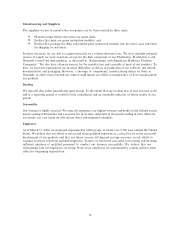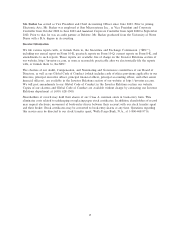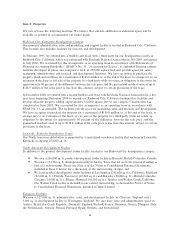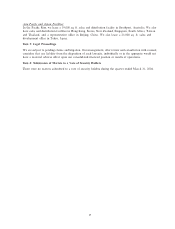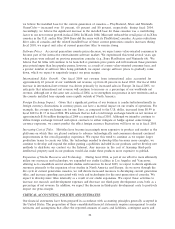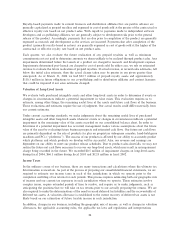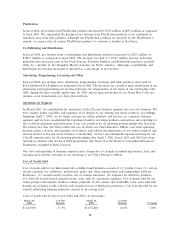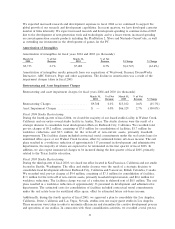Electronic Arts 2004 Annual Report Download - page 37
Download and view the complete annual report
Please find page 37 of the 2004 Electronic Arts annual report below. You can navigate through the pages in the report by either clicking on the pages listed below, or by using the keyword search tool below to find specific information within the annual report.
we believe the installed base for the current generation of consoles Ì PlayStation2, Xbox and Nintendo
GameCube Ì increased over 30 percent, 60 percent and 80 percent, respectively, during Ñscal 2004.
Accordingly, we believe the signiÑcant increase in the installed base for these consoles was a contributing
factor to our net revenue growth in Ñscal 2004. In March 2004, Microsoft reduced the retail price of its Xbox
consoles in the U.S. and in May 2004 Sony did the same with its PlayStation2 consoles. As price reductions
drive sales of consoles and the related installed base of these current generation consoles increases during
Ñscal 2005, we expect unit sales of current generation titles to remain strong.
Software Prices. As current generation console prices decrease, we expect more value-oriented consumers to
become part of the interactive entertainment software market. We experienced this trend several years ago
when prices were reduced on previous generation consoles (e.g., Sony PlayStation and Nintendo 64). We
believe that hit titles will continue to be launched at premium price points and will maintain those premium
price points longer than less popular games, however, as a result of a more value-oriented consumer base, and
a greater number of software titles being published, we expect average software prices to gradually come
down, which we expect to negatively impact our gross margin.
International Sales Growth. Our Ñscal 2004 net revenue from international sales accounted for
approximately 45 percent of our worldwide net revenue, up from 42 percent in Ñscal 2003. Our Ñscal 2004
increase in international net revenue was driven primarily by increased sales in Europe. In Ñscal 2005, we
anticipate that international net revenue will continue to increase as a percentage of our worldwide net
revenue, although not at the same rate as in Ñscal 2004, as we strengthen our presence in new territories and as
the console installed base expands more rapidly outside of North America.
Foreign Exchange Impact. Given that a signiÑcant portion of our business is conducted internationally in
foreign currency, Öuctuations in currency prices can have a material impact on our results of operations. For
example, the average exchange rate for one Euro, as compared to the U.S. dollar, increased from $0.99 in
Ñscal 2003 to $1.17 in Ñscal 2004. We estimate that we had a total foreign exchange beneÑt on net revenue of
approximately $156 million during Ñscal 2004 as compared to Ñscal 2003. Although we intend to continue to
utilize foreign exchange forward and option contracts to either mitigate or hedge against some foreign
currency exposures, we cannot predict the eÅect foreign currency Öuctuations will have on us in Ñscal 2005.
Increasing Cost of Titles. Hit titles have become increasingly more expensive to produce and market as the
platforms on which they are played continue to advance technologically and consumers demand continual
improvements in the overall gameplay experience. We expect this trend to continue as we require larger
production teams to create our titles, the technology needed to develop titles becomes more complex, we
continue to develop and expand the online gaming capabilities included in our products and we develop new
methods to distribute our content via the Internet. Any increase in the cost of licensing third-party
intellectual property used in our products would also make these products more expensive to publish.
Expansion of Studio Resources and Technology. During Ñscal 2004, as part of our eÅort to more eÇciently
utilize our resources and technology, we expanded our studio facilities in Los Angeles and Vancouver,
allowing us to consolidate several smaller studios and resources. In Ñscal 2005, we expect to devote signiÑcant
resources primarily to the expansion of our studios in North America and Europe. As we move through the
life cycle of current generation consoles, we will devote increased resources to developing current generation
titles, and increase spending associated with tools and technologies for the next generation of consoles. We
expect to develop more titles internally as a result of our studio expansions. We expect these activities to
increase our research and development expenses and decrease our third-party development costs, both as a
percentage of net revenue. In addition, we expect the decrease in third-party development costs to positively
impact our gross margin.
CRITICAL ACCOUNTING POLICIES AND ESTIMATES
Our Ñnancial statements have been prepared in accordance with accounting principles generally accepted in
the United States. The preparation of these consolidated Ñnancial statements requires management to make
estimates and assumptions that aÅect the reported amounts of assets and liabilities, contingent assets and
22


